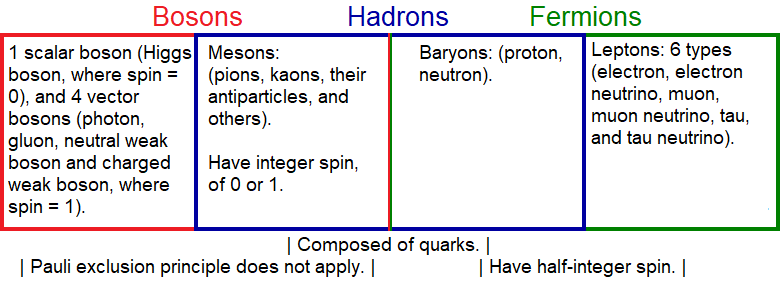
Particle Physics

All hadrons are either bosons or fermions, and only hadrons are composed of quarks. Bosons are force carriers and interactions.
Particles that aren't composed of other particles are elementary particles, which consists of the 1st and 4th box only.
While a proton consists of 2 up quarks and 1 down quark, and a neutron consists of 2 down quarks and 1 up quark, there isn't a fixed number of gluons in them, as they continuosly split and combine. Gluons holding the quarks together, is known as the strong force. The study of the strong force is QCD: quantum chromodynamics.
There is a phenonemon known as the melting point of a proton, at 5 trillion K, which makes quark-gluon plasma. Quark-gluon plasma behaves like a strongly-interacting liquid. This is the hottest man-made form of matter, called heavy ion collision, to produce the quark-gluon plasma, which is usually done with lead. (This was 1st done at the Relativistic Heavy Ion Collider at Brookhaven National Laboratory, on Long Island, in Upton, New York, in which their 1st collisions were in 2000 with gold, and hit 4.6 trillion K around 2005 (400 MeV)).
The Wigner function for a proton or and electron describes the probability distribution of its internal degrees of freedom (such as position and momentum of the constituent quarks) and can also incorporate information about its spin.
Inelastic scattering is where a particle (such as an electron) interacts with a target (such as a proton) and exchanges a photon with a quark in the target. This was 1st discovered in the 1950s, but the landmark discovery came in 1968 at Stanford Linear Accelerator Center. This led to the discovery of quarks (but not published until Oct. 20, 1969).
It's hard to get 2 protons to collide against each other. The 1st time that that happened, in a controlled lab experiment, was in 1959, at the CERN proton synchroton, a particle accelerater, to 28 gigavolts.
The 1st time protons were collided with either electrons or positrons, was done at DESY in Hamburg, Germany, with their HERA (particle accelerator), which was in operation from 1992 to 2007.
The most powerful proton-proton collisions occur at the Large Hadron Collider at CERN, which began operations in 2008, to 13 teravolts (7 TeV in July 2011). The LHC has a 16-mile circumference. About 2 billion LHC collisions are needed to produce 1 Higgs boson.
In May 2018, a new discovery at the Jefferson National Lab, found the pressure distribution of protons. Using deeply virtual Compton scattering (DVCS), where electrons scatter off protons and emit photons, scientists were able to measure the distribution of pressure inside the proton for the 1st time. They found that the proton's quarks, are about 10x greater than the pressure inside a neutron star, or 100 decillion Pascal (1035). This was done via their CLAS12 detector.
Earlier history.
The 1st positron was discovered in 1932 by physicist Carl Anderson at the Caltech. Pions and kaons were both discovered in 1947, at Berkeley, in the same lab under C. F. Powell. The 1st antiproton was discovered in 1955 at CERN, W and Z bosons in 1983, and the Higgs boson in 2012, all at CERN.
Upcoming history.
The Jefferson Nation Lab will do experiments with Li-7 in 2026. Li-7 will be in a high magnetic field so it stays polarized.
The Brookhaven National Labs is expected to have an electron-ion collider (EIC), which will cost $3 billion, in 2034. It will be the 1st accelerator that collides the nucleus with polarized protons.